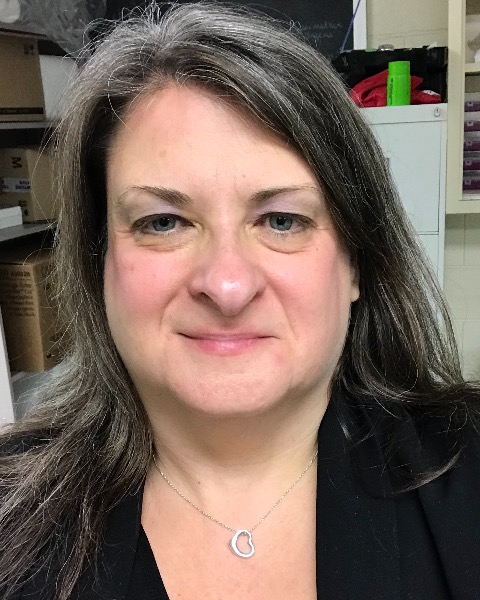Back
Poster, Podium & Video Sessions
Moderated Poster
MP38: Sexual Function/Dysfunction: Basic Research & Pathophysiology
MP38-06: Sonic hedgehog signaling in corpora cavernosal cells from prostatectomy, diabetic, hypertension and Peyronie's patients with erectile dysfunction.
Sunday, May 15, 2022
7:00 AM – 8:15 AM
Location: Room 222
Sarah Martin, Timothy Searl, Samuel Ohlander, Chicago, IL, Kevin McVary, Maywood, IL, Carol Podlasek*, Chicago, IL

Carol Ann Podlasek, PhD
Associate Professor
University of Illinois at Chicago
Poster Presenter(s)
Introduction: Erectile dysfunction (ED) treatments are minimally effective in prostatectomy and diabetic patients due to injury to the cavernous nerve. With denervation the critical smooth muscle undergoes apoptosis and the penis becomes fibrotic, thus altering corpora cavernosal architecture. In order to devise novel ED therapies, prevention of corpora cavernosal remodeling is critical. Sonic hedgehog (SHH) treatment by peptide amphiphile (PA) nanofiber hydrogel, suppresses smooth muscle apoptosis and improves erectile function in a rat CN injury ED model. We examine if human corpora cavernosal smooth muscle responds in a similar manner to SHH treatment.In this study we: 1.) Examine if human corpora cavernosal smooth muscle cells from primary culture of ED patient tissues, respond to Sonic hedgehog (SHH) treatment by increasing growth rate, as in our in vivo animal model. 2.) Determine if human corpora cavernosal cells from patients with differing underlying mechanisms of ED development (prostatectomy, diabetes, hypertension, cardiovascular disease), respond similarly to SHH treatment. 3.) Identify if organ culture conditions (glucose) affect growth of corpora cavernosal smooth muscle and the response to SHH signaling. 4.) Examine the vascular component of ED (hypertension and cardiovascular disease).
Methods: Human corpora cavernosal tissue was obtained from prostatectomy, diabetic, hypertension, cardiovascular disease and Peyronie’s (control) patients (n=40) that were under going prosthesis implant to treat ED. Primary cultures (n=17) were established, and corpora cavernosal cells from passage 3-4 were treated with SHH protein, MSA (control), 5E1 SHH inhibitor, and PBS (control). Growth was quantified by counting the number of cells using a hemocytometer at 3-4 days. The concentration of SHH protein for maximal growth was examined, in addition to a lipid modified more active SHH peptide.
Results: SHH treatment increased smooth muscle growth in human corpora cavernosal cells from prostatectomy, diabetic, and Peyronie’s patients in a similar manner (43-53%). SHH inhibition decreased smooth muscle growth (24-32%). There was no difference in growth using 25ug and 10ug SHH peptide. A more active (150X) SHH peptide further enhanced growth (20%). SHH protein increased growth more in diabetic smooth muscle under high glucose conditions. SHH inhibition was less effective under high glucose conditions. SHH treatment increased growth less in cells from hypertension and cardiovascular disease patients.
Conclusions: Corpora cavernosa smooth muscle from prostatectomy, diabetic, and Peyronie’s patients increased in response to SHH treatment in a similar manner, suggesting that SHH treatment would be beneficial to enhance smooth muscle regeneration in patients with ED of multiple origins. There is a threshold concentration of SHH protein above which smooth muscle growth is enhanced. Lipid modified SHH engendered a more robust growth response. High glucose conditions that may be present in under controlled diabetic patients would not detract from SHH usefulness as a protectant for corpora cavernosal morphology. Understanding how human corpora cavernosal tissue responds to SHH treatment is critical for clinical translation to ED patients.
Source of Funding: NIH/NIDDK DK101536
Methods: Human corpora cavernosal tissue was obtained from prostatectomy, diabetic, hypertension, cardiovascular disease and Peyronie’s (control) patients (n=40) that were under going prosthesis implant to treat ED. Primary cultures (n=17) were established, and corpora cavernosal cells from passage 3-4 were treated with SHH protein, MSA (control), 5E1 SHH inhibitor, and PBS (control). Growth was quantified by counting the number of cells using a hemocytometer at 3-4 days. The concentration of SHH protein for maximal growth was examined, in addition to a lipid modified more active SHH peptide.
Results: SHH treatment increased smooth muscle growth in human corpora cavernosal cells from prostatectomy, diabetic, and Peyronie’s patients in a similar manner (43-53%). SHH inhibition decreased smooth muscle growth (24-32%). There was no difference in growth using 25ug and 10ug SHH peptide. A more active (150X) SHH peptide further enhanced growth (20%). SHH protein increased growth more in diabetic smooth muscle under high glucose conditions. SHH inhibition was less effective under high glucose conditions. SHH treatment increased growth less in cells from hypertension and cardiovascular disease patients.
Conclusions: Corpora cavernosa smooth muscle from prostatectomy, diabetic, and Peyronie’s patients increased in response to SHH treatment in a similar manner, suggesting that SHH treatment would be beneficial to enhance smooth muscle regeneration in patients with ED of multiple origins. There is a threshold concentration of SHH protein above which smooth muscle growth is enhanced. Lipid modified SHH engendered a more robust growth response. High glucose conditions that may be present in under controlled diabetic patients would not detract from SHH usefulness as a protectant for corpora cavernosal morphology. Understanding how human corpora cavernosal tissue responds to SHH treatment is critical for clinical translation to ED patients.
Source of Funding: NIH/NIDDK DK101536

.jpg)
.jpg)